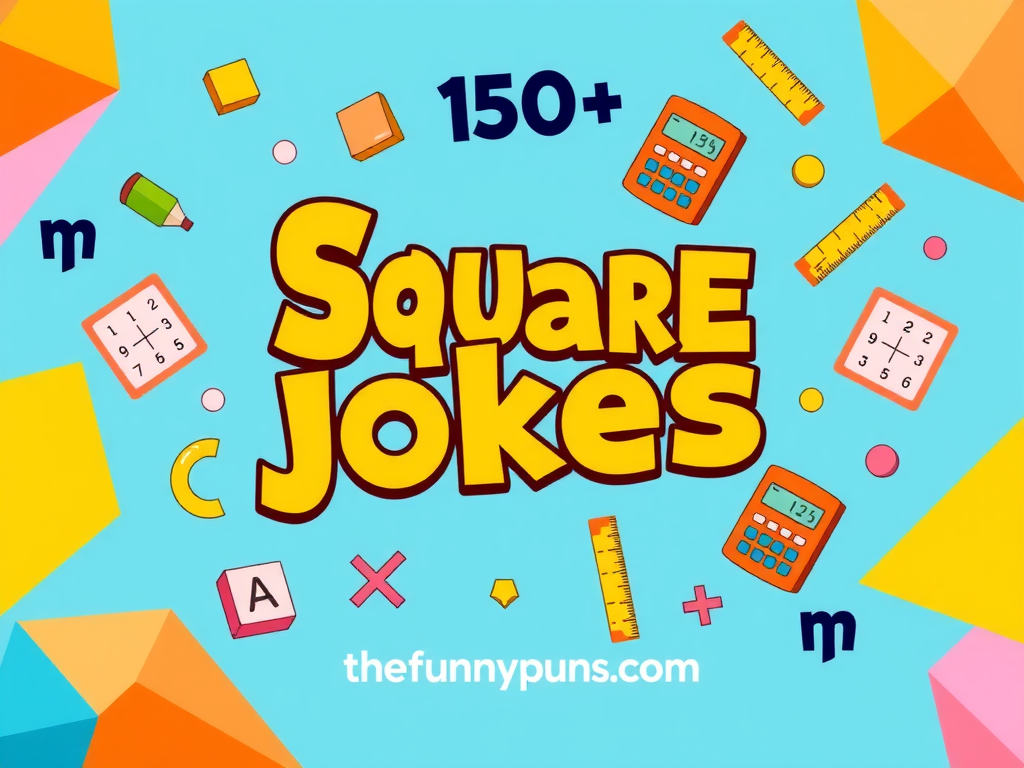Laughter is the best medicine, and square jokes are a perfect dose. These jokes are sharp, clever, and sure to tickle your funny bone.
Everyone loves a good joke. But square jokes bring a unique twist. They blend humor with geometry, appealing to both math lovers and casual joke enthusiasts. Whether you’re a student, teacher, or someone who enjoys a good laugh, these jokes are for you.
They are simple, yet witty, offering a fresh take on classic humor. Dive into the world of square jokes and enjoy the clever play on words and shapes. Ready to laugh? Let’s explore some hilarious square jokes that will leave you grinning from ear to ear.
Why Math Jokes Matter
Square jokes make learning math fun and engaging. They help students remember concepts through humor. Laughing together builds a positive classroom atmosphere.
Benefits Of Math Humor
Math jokes make learning fun. They bring joy to the classroom. Laughter helps students remember concepts. Jokes can reduce math anxiety. They make math less scary.
Students engage more with jokes. They pay better attention. Humor makes lessons interesting. It breaks the ice. Students feel more comfortable.
How Jokes Enhance Learning
Jokes create a relaxed environment. This helps students focus. They can understand better. Funny math problems are more memorable. They stick in the mind.
Teachers can use jokes to explain hard topics. This makes them easier. Kids learn without pressure. Laughter boosts memory. It helps in long-term retention.

Credit: www.pinterest.com
Classic Square Jokes
Square jokes have been around for a long time. They still make people laugh. A simple joke can make your day better. Here are some timeless favorites.
| Joke | Punchline |
|---|---|
| Why was the square sad? | Because it had too many problems! |
| What do squares eat for lunch? | Square sandwiches! |
| Why did the square go to school? | To become a well-rounded person! |
These jokes are easy to remember. They work because they are simple. Kids and adults both enjoy them.
Squares are easy to understand. Their shape is familiar. This makes the jokes relatable. Simple jokes often have the best impact.
Modern Square Humor
Math jokes can be fun. Squares are a favorite topic. Why? Because they are simple and easy to understand. Here is a joke: Why was the square sad? It had too many problems. Another one: What do you call a square that talks a lot? A chatterbox. These jokes make math less scary. They make learning fun. Kids love them. Adults too. Laughter helps everyone enjoy math.
Modern jokes fit today’s world. They use current events. They use pop culture. Here is a modern joke: Why did the square go to school? To become a well-rounded person. Another: What do you get if you cross a square and a computer? A nerdy box. These jokes keep up with the times. They make math relatable. Everyone can enjoy them.
Square Jokes For Kids
Kids love jokes. Especially square jokes. They are easy to remember. Also, they are funny.
What did the square say to the circle? “You’re pointless!” Isn’t that hilarious? Simple humor. Kids enjoy it.
Square jokes can teach shapes. Kids learn while laughing. They remember better through fun. Laughter helps them relax. This makes learning easier.
Here’s another one. Why did the square go to school? To become well-rounded! Kids will love it. And they learn about shapes.
Square Jokes For Adults
Why did the square get a job? It wanted to be a well-rounded employee.
What did the square say to the circle? “You’re pointless without me.”
Why did the square break up with the triangle? It found the triangle’s angles too acute.
Why did the square bring a pencil to the office? To stay sharp.
What did the square say during the meeting? “Let’s get to the point.”
Why did the square never get lost at work? It always took the right path.
Math Puns And Wordplay
Math puns can be so funny. Especially jokes about squares. Squares are special shapes in math. They have four equal sides. Many jokes play with this idea.
A good square joke can make you smile. For example, why was the square always calm? Because it was right-angled!
Another funny one is about the square’s favorite sport. It’s boxing! These jokes use wordplay. They are simple but clever.
Cultural Variations In Math Jokes
Math jokes vary by country. In some places, jokes about square numbers are popular. Other regions prefer pi jokes. A square is a shape with four equal sides. In the USA, jokes about squares can be about people who are not fun. In other countries, squares are just math shapes. The humor changes with culture.
Jokes can be tricky. Some jokes are funny in one language but not in another. A joke about a triangle might confuse someone. Math symbols like plus and minus can mean different things. Understanding the culture helps make the joke funny. Always think about who will hear the joke.
Creating Your Own Square Jokes
Think about squares in funny ways. What can they do? Think of silly situations. Maybe a square gets stuck in a round hole. Play with words. Squares sound like “squeers.” Use this to make funny puns. Let your mind wander. Don’t worry if it sounds silly. Silly is good for jokes.
Share your jokes with friends. Watch their faces. Do they laugh? If yes, great job! If not, try again. Write your jokes in a notebook. Practice telling them out loud. Make it fun. Laughter is the best reward.
Square Jokes In Pop Culture
Square jokes are popular in movies and TV shows. They often make people laugh. For example, in some movies, characters might say, “You’re such a square!” It means someone is boring or old-fashioned. Cartoons also use square jokes. They might show a character literally turning into a square. This makes kids laugh a lot.
Mathematicians love squares. They use them in their work. Pythagoras is a famous mathematician. He created the Pythagorean Theorem. It is about squares and triangles. Euclid also loved squares. He wrote many books about geometry. His work helps us understand squares better.

Credit: ccclib.bibliocommons.com
Sharing Square Jokes Online
Facebook is a great place to share square jokes. Many people use it daily. Funny content spreads quickly there. Twitter is also good. Short jokes work well on Twitter. You can use hashtags to reach more people. Instagram is another option. Make a funny image or video. Share it with your followers. TikTok is perfect for short, funny videos. Use popular music and trends. Many people will see your joke.
Join math groups online. Facebook groups are a good start. Share your jokes there. Reddit has many math communities too. Post your jokes in these groups. Math forums are another option. People there love math humor. They will enjoy your jokes. Engage with comments. Reply to people. Build a friendly community. Laugh together and share more jokes.

Credit: www.lakemills.lib.wi.us
Frequently Asked Questions
What Are Square Jokes?
Square jokes are funny puns or quips about squares and their properties.
Why Are Square Jokes Funny?
They play with math concepts in unexpected ways, making them amusing.
Can You Share A Simple Square Joke?
Sure! Why was the square always calm? Because it had all four sides under control!
Are Square Jokes Suitable For Kids?
Yes, they are clean and educational, perfect for kids.
How Do Square Jokes Help In Learning?
They make learning math fun and engaging through humor.
Where Can I Find More Square Jokes?
You can find them in math joke books or online joke sites.
Do Square Jokes Help In Teaching Geometry?
Yes, they can make geometry lessons more interesting and memorable.
What Is A Popular Square Joke?
Why did the square go to school? To become well-rounded!
Can Square Jokes Be Used In Presentations?
Definitely, they can add humor and make your presentation memorable.
Are Square Jokes Popular?
Yes, especially among math enthusiasts and teachers.
Conclusion
Square jokes always bring a smile. They are simple and funny. Share them with friends and family. Laughter is the best medicine. Keep the humor going. Who knew squares could be so entertaining? Next time you’re bored, remember these jokes.
Make someone’s day brighter. Humor connects us all. Spread joy with every square joke you tell.


Comments